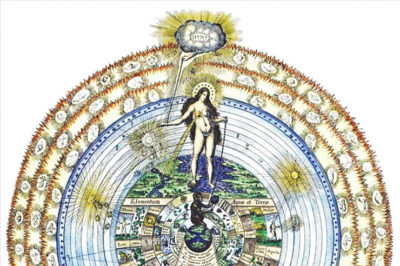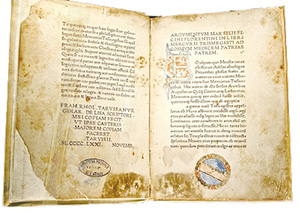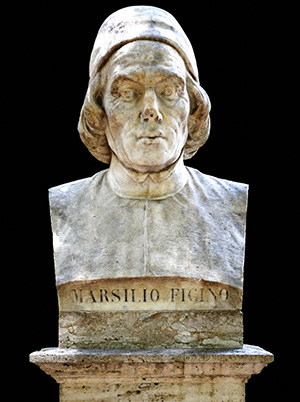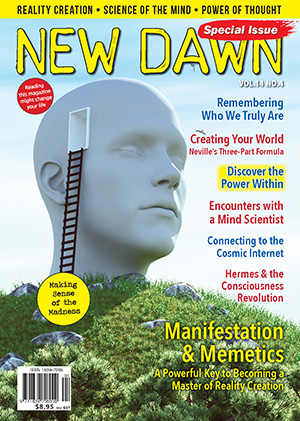From New Dawn Special Issue Vol 14 No 4 (Aug 2020)
The Hermetic revival in the Renaissance was inspired by a belief that humanity could remake its own destiny. Was this promethean arrogance, or the recognition of powers that we need to acknowledge?
The philosopher Jean Gebser argued that a profound shift in human consciousness took place in 1336 when the Italian Renaissance poet Francesco Petrarch made his ascent of Mt. Ventoux in France.1 This, Gebser said, was the first time someone had bothered to climb a mountain in order to see the view. Men had, of course, encountered mountains before, but always as obstacles. Petrarch made his climb on purpose.
Gebser relates Petrarch’s climb to the rise of perspective in European painting, and to a “new, realistic, individualistic, and rational understanding of nature.” No longer “fixed” in place, one creature among others, as their medieval ancestors were, human beings could now “rise above their station,” survey the vast landscape of creation and map out their destiny.
Gebser, I believe, is correct. And I would argue that perhaps some of the greatest exponents of this new consciousness were the Hermeticists of the Italian Renaissance.
In her classic work Giordano Bruno and the Hermetic Tradition, the British scholar Frances Yates writes that “The great forward movements of the Renaissance all derive their vigour, their emotional impulse, from looking backwards.”2 That the Renaissance was a time of rediscovery, of the resurrection of classical learning, is a truism. But what is not so well known is that it was also a return to the ancient teachings of the most famous magician of all time, Hermes Trismegistus, “thrice-greatest Hermes.” The writings that came to be known as “Hermetic” – including the Emerald Tablet, perhaps the most famous magical text in history – were considered by the Renaissance to be of profound antiquity. They were believed to have been set down in a distant Golden Age when men and gods still walked and talked together. For Hermeticists like Marsilio Ficino (1433–1499), Giovanni Pico della Mirandola (1463–1494), and Giordano Bruno (1548–1600), the rediscovery of the Hermetic books meant that the way back to an original divine state, to mankind’s true heritage, had been given to them.
As the Greek god of writing, learning, language, and speech, Hermes held tremendous importance for Renaissance man, whose consciousness was profoundly attuned to the text. It is difficult for us to grasp just how central he was. In 1460, when the humanist patron Cosimo de’ Medici received a Greek copy of the Corpus Hermeticum, a collection of magical texts believed to be authored by Hermes, he ordered his scribe, Marsilio Ficino, to break off translating Plato in order to start work immediately on the Hermetic texts. Even Plato, to whom all of Western philosophy is said to be a “footnote,” must step aside for the thrice-greatest one, presumably so that Cosimo could read him before he died.3
The Renaissance desire to drink the waters of wisdom at their source dictated this urge. For the Renaissance mind, Hermes Trismegistus was identified with the Egyptian god Thoth and his profound knowledge of occult mysteries; hence he was far older than Plato and was, in fact, the source of the divine Plato’s mystical philosophy. As Yates writes, “Renaissance respect for the old, the primary, the far-away, as nearest to the divine truth, demanded that the Corpus Hermeticum should be translated before Plato’s Republic or Symposium.”4
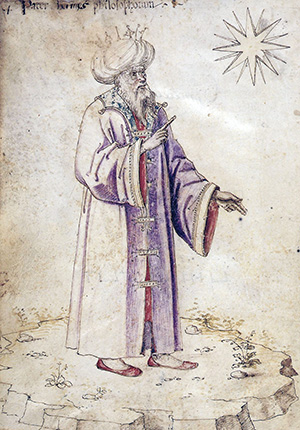
Yet as Yates points out, this Renaissance reverence for a Golden Age of Hermetic wisdom, however pious, was misguided. The works which inspired the Renaissance magician, and which he believed to be of ancient, primordial pedigree, are now thought to have been written in the early centuries of the Christian era, c.200-300 CE, products of the gnostic syncretism that characterised the decline of Greek philosophy.
Far from being contemporary with Moses, farther still from the pristine rays of the original Egyptian sun, the Hermetic texts that ousted Plato were written not in the ancient past by a philosopher god, but by unknown scribes a little more than a millennium earlier. Nevertheless, the “historical truth” about the author of the Emerald Tablet, Picatrix, and the Divine Pimander seems less important than the influence he and the works attributed to him had on a pivotal time in the evolution of Western consciousness.
The Hermetic message of knowledge, symbolised in Hermes’ role as guide and scribe, offers the central contrast with the medieval image of man as a sinful creature whose only chance of salvation lies in the consciousness of his imperfections: Knowledge is power for Hermetic man – power over nature, himself, and his destiny. As Virgil (who resembles Hermes in his role of psychopomp) guided Dante through the darkness of the nether realms, so Hermes Trismegistus, fount of wisdom and source of the prisca theologia – the ancient wisdom behind the religions of the world – guided Renaissance man through the shadows of his lower nature and the snares of the astral demons to his true heritage as magus, master of the world.
Escape from the Stars
For Renaissance man, the universe was a living intelligence, a hierarchy of powers whose influence was felt through the emanations of the stars. We who read our daily horoscopes half tongue-in-cheek, half eager for instruction, can barely grasp the fascination of astrology for the Renaissance mind. The untutored endured their destiny, solaced only, if at all, by the thought that their misfortunes were the result of their fallen nature.
Hermetic knowledge meant that Renaissance man was no longer wholly subject to this astral influence; he now had it in his power to modify, even master, his fate. Knowing the correspondences between microcosm and macrocosm, the Hermeticist could create a magical “strange attractor,” drawing or repelling what astral influence he chose. Understanding the links among the various symbols, scents, colours, metals, numbers, dates, times, places, states of mind, and astral influences, the Renaissance Hermeticist had gained a power his medieval brother lacked – or avoided, as such knowledge was considered demonic. To challenge fate was a mark of hubris, rejection of divine providence, and alliance with the Evil One. The hurdle facing the Renaissance Hermeticist was to show that the wisdom of the thrice-greatest one was not antithetical to the received Christian doctrine. Some, like Giordano Bruno, were not successful. Others, like Marsilio Ficino, were.
Ficino’s Natural Magic
The world of Marsilio Ficino’s magic has a strange, melancholy atmosphere, an eerily familiar landscape of anxiety and dread. As in Kafka’s fictions, the sense of an overarching power whose ebb and flow determines our fate pervades his Hermetic investigations. Author of the influential Commentaries on Plato’s Symposium (1469), Ficino was subject, he believed, to the restrictive influence of Saturn, a complaint common to students and scholars. He sought to escape its melancholic emanations by surrounding himself with the symbols of more beneficent solar, jovial, and venereal powers. For James Hillman and the school of archetypal psychology, Ficino’s magic represents an attempt to “consider all events in terms of their meaning and their value for soul.”5
Yates, writing some years earlier than Hillman, had ironically previsioned Ficino’s value for psychotherapy. Commenting on his prescriptions for a non-Saturnian environment, she remarks, “We might be in the consulting room of a rather expensive psychiatrist who knows that his patients can afford plenty of gold and holidays in the country.”6 Ficino’s Hermetic antidotes to devitalising Saturn are collected in his treatise on medicine, Libri de vita, first published in 1489.
It was not unusual for a Renaissance medical text to offer astrological advice; assumptions about the relation between different zodiacal signs and parts of the body and the influence of the planets on temperament were as fundamental then as our ideas about genetics are now. What was daring about Ficino’s prescriptions were his use of magical talismans, a practice condemned by the Church Fathers.
In Ficino’s time it was still possible to advocate a “good,” “natural” magic that employed the beneficent forces of the anima mundi, or “soul of the world,” rather than the demonic energies of the stellar spirits. But time was running out on this tolerance. Hedging his advocacy of the Hermetic art with detailed qualifications, Ficino suggested that the use of talismanic magic was a natural outcome of the Platonic wisdom that ran parallel to religious dogma. The basic idea behind his “astral magic” – and behind Hermeticism in general – is that correspondences exist between the world of the Divine Intellect (Plato’s Ideal realm) and the created world. The magician’s own imagination is the bridge linking the two.
Intermediary between these is the “soul of the world,” an idea prominent in Plotinus and the Neoplatonists of late antiquity. This “soul” was found in images which, in true Platonic fashion, were not mere signs but symbols, potent vessels retaining an element of the original, supersensible Idea. For the Renaissance Hermeticist, the images found in the Hermetic texts, close to the fundamental source, had exceptional power.
One aspect of this magic was a kind of “reparation” of the sensible world, which, through its distance from the divine source, was subject to deterioration. By refashioning images of the external world in his imagination, the Renaissance magus could channel the divine influence into the imperfect world of the senses. By thus employing the talismanic devices fashioned through his knowledge of the Hermetic books, Ficino had delivered to Renaissance man the means of becoming co-creator with God. This was a far cry from the humble, sinful creature of the Middle Ages.
Pico Della Mirandola and the Dignity of Man
With Giovanni Pico della Mirandola, the hesitancy that characterises Ficino’s magic disappears and the new-found confidence in man as a spiritual power arrives in full force. Where Ficino was content to open the natural forces of the anima mundi to the philosopher-magus, Pico is determined to bring human consciousness to the very source of being itself. In the technical magical sense, this means mastering the arcane secrets of Cabala, the ancient Hebrew mystical tradition of deciphering the divine import, the hidden logos, locked in numbers and the alphabet. In the broader sense of humankind’s consciousness of itself, it means a new awareness of our powers and strengths, our “dignity,” a term hardly applicable to medieval man.
The influence of Hermes on Pico is evident in the opening paragraph of his most famous work, Oration on the Dignity of Man, which he delivered in Rome in 1486, at the hoary age of 24. He begins by remarking that the esteemed Abdala the Saracen, when asked what in the world was most worthy of wonder, had answered “man.” Pico supports this conclusion by quoting Hermes. “What a great miracle is man,” the thrice-greatest one remarks in the Hermetic text known as Asclepius. Pico sets off his rhetorical fireworks in order to state this case as persuasively as possible.
Pico’s Cabalistic investigations opened doors for Christian variants on an adamantly Jewish tradition. It made possible the kind of Cabalistic magic associated with modern Hermetic societies such as the Hermetic Order of the Golden Dawn, whose membership included luminaries like W.B. Yeats and dark stars like Aleister Crowley. Critical of Ficino’s merely “natural” magic, Pico argued that for magic to be effective, it must reach beyond the stars, into the higher, supercelestial spheres. Pico’s Cabalistic magic tapped the forces that lay behind the sensible world: angels, archangels, the ten sefirot or powers of God of the Cabalistic Tree of Life, even God himself – as aspiration the cautious Ficino would never openly avow.
Instead of merely manipulating astral effluvia, knowledge of the secret import of numbers and the Hebrew alphabet meant the Cabalist magus could refashion the very matrix of being. But Pico’s Hermetic message is not limited to this specific magical practice. His basic argument is that man is a god who, as a contemporary writer put it, “has forgotten his heritage and come to accept that he is a beggar.”7 It is Pico’s mission to remind us of our roots.
Central to Pico’s message is that unlike all other created beings, man has no fixed nature. “The Supreme Maker decreed,” he states in the Oration, that man “should have a share in the particular endowment of every other creature…. We have given you, O Adam, no visage proper to yourself”8 – a belief echoed centuries later by Jean-Paul Sartre, who argued that man had existence but not essence. Thus man is protean, able to participate in all dimensions and spheres of reality.
The microcosm is the macrocosm, at least potentially. “We have made you a creature neither of heaven nor of earth, neither mortal nor immortal, in order that you may, as the free and proud shaper of your own being, fashion yourself in the form you may prefer”9 – a Hermetic proposition if there ever was one. No longer secure in his medieval slot, man now can make of himself what he will. He can “descend to the lower, brutish forms of life,” or ‘’rise again to the superior orders whose life is divine… Whichever of these a man should cultivate, the same will mature and bear fruit in him.”10 With the works of Plato, the Gospels, the writings of the Church Fathers and, above all, the books of the incomparable Hermes Trismegistus at his disposal, Pico goes for the alchemical gold, opts for the life divine, and strives to actualise his high inheritance.
This supreme self-confidence is a sign of the hubris that for some is the most pervasive gift our Renaissance forefathers have left us. Yet, as Yates writes, ‘’The profound significance of Pico della Mirandola in the history of humanity can hardly be overestimated.”11 After him, European man had the confidence to act upon the world and to control his destiny through knowledge. Unfortunately, Pico himself did not long enjoy his newly won status, dying of fever at the age of 31. His incendiary rhetoric suggests a bright but short-lived flame.
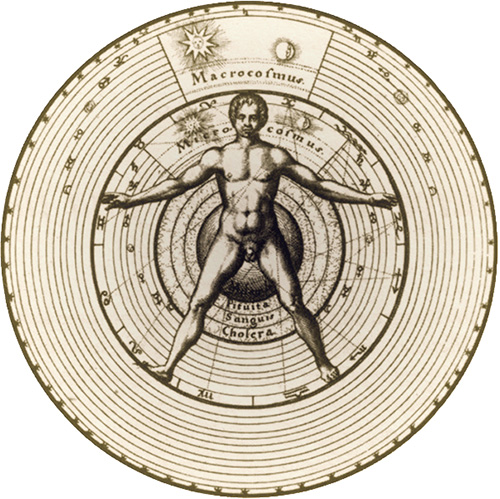
Bruno and the Egyptian Revival
Speaking of flames in the context of Giordano Bruno brings other images to mind. Bruno is remembered as a martyr for the Copernican heliocentric solar system: he was burned at the stake by the Catholic Church in 1600 for his heresies. Yet the picture of Bruno as a champion of a “modern” cosmology is inaccurate. The godless, meaningless universe of big bangs and black holes that grew out of the Copernican revolution would have been as repellent to Bruno as his own Hermetic aspirations were to the churchmen who immolated him.
Bruno did not burn because he favoured a cosmos reduced to mere energy and matter, drained of its magical, spiritual character. Bruno took Pico’s challenge to reclaim our divine heritage so seriously that he attempted to revive the ancient Egyptian, Hermetic religion – an injudicious if heroic project. Bruno wished to break the hold of the Church over men and to erect in its place the pantheon of mankind’s true spiritual guides, the gods of ancient Egypt. It is for this, and not for his place in the standard histories of “the warfare between science and religion,” that he should be remembered.
Bruno’s contribution to the Hermetic Renaissance is central and cannot be adequately reviewed here. But two aspects of his work stand out: his proposed Egyptian revival and his mastery of the Art of Memory.
Yates has written at length on this ancient art, and the interested reader can get a definitive account of it in her book The Art of Memory. Known to the rhetoricians of antiquity, revived by Renaissance scholars, and used in magical practices by modern esotericists, “magical memory,” as Bruno’s mnemonic discipline is known, is a sine qua non of the true magus. A central theme in Bruno’s Hermetic magic was the reflection of the universe in the mind of the magus.
In The Mind to Hermes, book XI of the Corpus Hermeticum, the mens, or Divine Mind, addresses Hermes about this discipline. “Unless you make yourself equal to God, you cannot understand God,” the Divine Mind advises the thrice-greatest one. “Like is not intelligible save to like. Make yourself grow to a greatness beyond measure, by a bound free yourself from the body; raise yourself above all time, become Eternity; then you will understand God.”12
One way in which Bruno strove to accomplish this end was by engraving on his consciousness the divine images, the celestial archetypes, which, as the title of his early work De umbris idearum (1582) suggests, were the shadows of the Platonic Ideas. He used a method familiar to rhetoricians of antiquity. The ancient Roman orators would memorise a series of places in an imaginary building and attach to these places images to remind them of the points of their speech. As they gave the speech, they mentally “walked” through the building, prompted by the memorised images. If we think of a virtual reality tour of an architectural site or a trip through a castle in a video game, we have a fair idea of the process, except that the practitioners of the art used nothing but their own powers of imagination. As Yates points out, it is difficult for us to imagine a memory capable of the complex, vivid detail achieved by the ancient mnemotechnicians.
Reviving this practice, Bruno adapted it to his magical projects. Taking the divine images from the Hermetic books, the Renaissance magus fixed these in his imagination, thus furnishing his inner world with a blueprint of the universe. In the process, he acquired magical powers enabling him to act upon the world.
By thus reflecting the universe in his mind, the Renaissance magus became a co-creator with God, fulfilling Pico’s injunction that man must embody the highest and greatest good, a privilege vouchsafed to him alone. The magical images were arranged in the mnemonic system with images of the terrestrial world – plants, animals, minerals – and with the sum of human knowledge symbolised by the images of great thinkers and inventors. The possessor of this system thus stood above space and time, reflecting within his consciousness the entire universe of nature and man. He thus met the Hermetic challenge of “becoming Eternity.”
In practising this magical memory, Bruno hoped to break through the dense matter of the terrestrial world and to return to his true stature as an agent of the divine mind. This gnostic heresy – that man is not a mere creature but embodies the archetypal energies behind the world of appearances – is a radical development of Ficino’s more subtle “astral magic.” It is a move away from manipulating natural forces toward actualising the divine powers dormant within us.
Bruno’s “Egyptian revival,” in which he hoped to bring back the ancient Hermetic religion with its appreciation of man as magus, was powered by his profound antipathy to the image of man promulgated by the Church. A central part of the Asclepius is the lament over the decline of the ancient teachings, the darkening of mankind’s spiritual light, and the fall into forgetfulness of its divine heritage.

For Bruno, the Christian church was one of the agents responsible for this decline. Like Pico, Bruno considered it his mission to awaken men to their true place in the cosmos. In the Spaccio della bestia trionfante (1584), Bruno glorifies the magical, Hermetic religion of the Egyptians, and throws Ficinian caution to the wind by declaring that the return of that religion is nigh. There are no half-measures here: Bruno’s reformation begins with a cleansing of the zodiac by the divine Sophia, Isis, and Momus, archetypal powers of the Hermetic doctrine. Not only man’s life on earth, but the entire cosmos, must regain its magical heritage.
In the Cena de le ceneri (1584), a satire on the academic pedants who reject his Hermetic wisdom, Bruno proclaims the new Copernican theory of a heliocentric solar system as evidence that the Hermetic revival has come. His use of Copernicus, coupled with the bombastic, aggressive personality often found in men of genius and spirit, led to his death. After years of bitter struggle against the papal forces, the avatar of the new Hermetic age was burned alive at the hands of the Inquisition in 1600 on the Campo de’ Fiori in Rome.
In recent years a critical attitude toward the Renaissance magicians has grown up among some “anti-modern” thinkers. The eco-feminist Charlene Spretnak, recognising that the “core concept of the Ancient Wisdom is that man is a terrestrial god who can shape his own destiny and control nature,” sees the Renaissance magicians as ultimately “triumphal selfproclaimed titans, desperately denying the existence of a larger reality… of which human intelligence is only a part.”13 Their patriarchal, egocentric world views are out of touch with the more feminine, “nature-friendly” sensibilities that Spretnak advocates.
That our contemporary abuse of nature has its roots in the rise of modern science, associated with the Renaissance, is, I think, true. Yet the urge to “put man in his place” exhibited by “ecologically correct” thinkers carries some dangers of its own, not the least of which is a dampening of self-belief and a nurturing of cosmic laziness. As the eighteenth-century theosopher Louis Claude de Saint-Martin wrote of the men of his time, “They have believed themselves to be obeying the dictates of humility when they have denied that the earth and all that the universe contains only exists on man’s account, on the ground that the admission of such an idea would be only conceit. But they have not been afraid of the laziness and cowardice which are the inevitable result of this affected modesty…. Where is the pilot that will guide us between these hidden reefs of conceit and false humility?”14
Nearly three centuries later, we are still faced with Saint-Martin’s question. Humility, acceptance of fate, and knowing our station in the scheme of things may make for a more secure cosmos. Yet having once glimpsed our powers, it would be inauthentic, not humble, to turn away from them. We are still faced with the choice given to Renaissance man: to actualise our godlike potentials or to ignore them. Extravagance, passion, fierce individualism: our modern consciousness has its roots in these Renaissance virtues. Our task is to refine, not deny them.
This article was originally published in GNOSIS #40 (Summer 1996) under the title ‘The Renaissance of Hermetic Man’ and later incorporated into Gary Lachman’s book The Quest for Hermes Trismegistus (Floris Books 2011).
Footnotes
1. Jean Gebser, The Ever-Present Origin (Athens, Ohio: Ohio University Press, 1985), 15
2. Frances Yates, Giordano Bruno and the Hermetic Tradition (New York: Vintage Books, 1964), 1
3. Ibid., 13
4. Ibid., 13-14
5. James Hillman, Loose Ends (Dallas, Texas: Spring Publications, 1986), 155
6. Yates, 63
7. Colin Wilson, The Occult (London: Hodder & Stoughton, 1971), 320
8. Giovanni Pico della Mirandola, Oration on the Dignity of Man (Chicago, ID.: Gateway Editions, 1956), 6-7
9. Ibid.
10. Ibid., 8
11. Yates, 116
12. Ibid., 198
13. Charlene Spretnak, States of Grace: The Recovery of Meaning in the Postmodern Age (San Francisco: HarperSanFrancisco, 1991), 197, 202
14. Quoted in Wilson, 318-19
© New Dawn Magazine and the respective author.
For our reproduction notice, click here.

